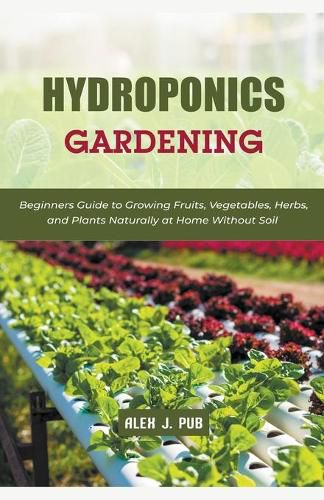Readings Newsletter
Become a Readings Member to make your shopping experience even easier.
Sign in or sign up for free!
You’re not far away from qualifying for FREE standard shipping within Australia
You’ve qualified for FREE standard shipping within Australia
The cart is loading…






This title is printed to order. This book may have been self-published. If so, we cannot guarantee the quality of the content. In the main most books will have gone through the editing process however some may not. We therefore suggest that you be aware of this before ordering this book. If in doubt check either the author or publisher’s details as we are unable to accept any returns unless they are faulty. Please contact us if you have any questions.
Standard field farming practices have seen a lot of negative press recently, from concerns about soil erosion to massive water consumption to food-bourne illness breakouts. Hydroponic systems are soil-less, water-based farming processes. Rather than using soil for plant nutrition, crops are fed nutrient-rich water, negating a lot of the baggage that comes with soil-based methods.
Over the last decade, people’s interest in how their food is produced has increased greatly. More consumers want safe food that’s been produced with sustainable, mindful growing practices and is free from pesticide residues. As a result, more consumers are choosing to grow their own food and many are exploring hydroponics to achieve it.
In hydroponic gardening systems, plants are placed in a growing medium and nutrients are provided directly to the roots. Many people are surprised that plants don’t require soil to live, but soil can sometimes be a very inefficient growing medium. Plants expend a great deal of energy growing root systems so they can search the soil for the water and nutrients they need to survive. By providing constant and readily available nutrition, hydroponics allows plants to grow up to 50% faster than they do in soil. If you’re thinking of embarking on a hydroponics gardening, you’ll first need to learn the fundamental concepts of growing plants hydroponically.
In this book, you’ll discover the basics of hydroponics as well as the numerous advantages and slight disadvantages of using a hydroponics system. Not only are individuals growing their own food nowadays, but restaurants and even grocery stores have implemented their own gardening centers to offer fresh, local produce to their customers. They have heard the voice of the people wanting uncontaminated foods grown in their own community.
Get your copy now to get started
$9.00 standard shipping within Australia
FREE standard shipping within Australia for orders over $100.00
Express & International shipping calculated at checkout
This title is printed to order. This book may have been self-published. If so, we cannot guarantee the quality of the content. In the main most books will have gone through the editing process however some may not. We therefore suggest that you be aware of this before ordering this book. If in doubt check either the author or publisher’s details as we are unable to accept any returns unless they are faulty. Please contact us if you have any questions.
Standard field farming practices have seen a lot of negative press recently, from concerns about soil erosion to massive water consumption to food-bourne illness breakouts. Hydroponic systems are soil-less, water-based farming processes. Rather than using soil for plant nutrition, crops are fed nutrient-rich water, negating a lot of the baggage that comes with soil-based methods.
Over the last decade, people’s interest in how their food is produced has increased greatly. More consumers want safe food that’s been produced with sustainable, mindful growing practices and is free from pesticide residues. As a result, more consumers are choosing to grow their own food and many are exploring hydroponics to achieve it.
In hydroponic gardening systems, plants are placed in a growing medium and nutrients are provided directly to the roots. Many people are surprised that plants don’t require soil to live, but soil can sometimes be a very inefficient growing medium. Plants expend a great deal of energy growing root systems so they can search the soil for the water and nutrients they need to survive. By providing constant and readily available nutrition, hydroponics allows plants to grow up to 50% faster than they do in soil. If you’re thinking of embarking on a hydroponics gardening, you’ll first need to learn the fundamental concepts of growing plants hydroponically.
In this book, you’ll discover the basics of hydroponics as well as the numerous advantages and slight disadvantages of using a hydroponics system. Not only are individuals growing their own food nowadays, but restaurants and even grocery stores have implemented their own gardening centers to offer fresh, local produce to their customers. They have heard the voice of the people wanting uncontaminated foods grown in their own community.
Get your copy now to get started